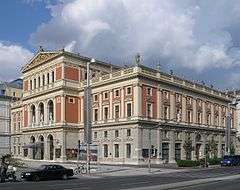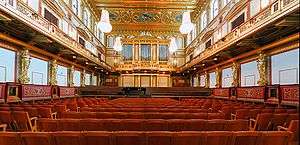Musikverein
| Wiener Musikverein | |
|---|---|
 Wiener Musikverein, June 2006 | |
| General information | |
| Type | Concert hall |
| Architectural style | Neoclassical |
| Town or city | Vienna |
| Country | Austria |
| Current tenants | Vienna Philharmonic |
| Inaugurated | 6 January 1870 |
The Wiener Musikverein (German pronunciation: [ˌviːnɐ muˌziːkfɛɐ̯ˈʔaɪ̯n]; Viennese Music Association), commonly shortened to Musikverein, is a concert hall in the Innere Stadt borough of Vienna, Austria. It is the home of the Vienna Philharmonic orchestra.
The "Great Hall" (Großer Saal), due to its highly regarded acoustics, is considered one of the finest concert halls in the world, along with Berlin's Konzerthaus, the Concertgebouw in Amsterdam, and Boston's Symphony Hall.[1] With the exception of Boston Symphony Hall,[2] none of these halls were built in the modern era with the application of architectural acoustics, and all share a long, tall, and narrow shoebox shape.
Building
The building is located on Dumbastraße/Bösendorferstraße behind the Hotel Imperial near the Ringstraße boulevard and the Wien River, between Bösendorferstraße and Karlsplatz. However, since Bösendorferstraße is a relatively small street, the building is better known as being between Karlsplatz and Kärntner Ring (part of Ringstraße loop). It was erected as the new concert hall run by the Gesellschaft der Musikfreunde, on a piece of land provided by Emperor Franz Joseph I of Austria in 1863.
The plans were designed by Danish architect Theophil Hansen in the Neoclassical style of an ancient Greek temple, including a concert hall and a smaller chamber music hall. The building was inaugurated on 6 January 1870.[3] A major donor was Nikolaus Dumba, industrialist and liberal politician of Greek descent, whose name the Austrian government gave to one of the streets surrounding the Musikverein.

The Großer Musikvereinssaal (Great Hall), or Goldener Saal (Golden Hall), is about 49 m (161 ft) long, 19 m (62 ft) wide, and 18 m (59 ft) high. It has 1,744 seats and standing room for 300. The Skandalkonzert of 1913 was given there, and it is the venue for the annual Vienna New Year's Concert.
The Great Hall's lively acoustics are primarily based on Hansen's intuition, as he could not rely on any studies on architectural acoustics. The room's rectangular shape and proportions, its boxes and sculptures allow early and numerous sound reflections.
The original equipment comprised a historic pipe organ built by Friedrich Ladegast, and the first organ recital was held by Anton Bruckner in 1872. The present-day organ was originally installed in 1907 by the Austrian firm of Rieger Orgelbau, highly esteemed by musicians such as Franz Schmidt or Marcel Dupré, and rebuilt in 2011.
.jpg)
Since 2001, the building has been undergoing renovation, and several new rehearsal halls have been installed in the basement.
Halls
| Venue | Size | Height | Seats |
|---|---|---|---|
| Großer Musikvereinssaal (Goldener Saal) | 48.8 × 19.1 m | 17.75 m | 1744 seats and c. 300 standing |
| Brahmssaal | 32.5 × 10.3 m | 11 m | 600 seats |
| Gläserner Saal/Magna Auditorium | 22 × 12.5 m | 8 m | 380 seats |
| Metallener Saal | 10.5 × 10.8 m | 3.2 m | 70 seats |
| Steinerner Saal/Horst Haschek Auditorium | 13 × ~8.6 m | ~3.3m | 60 seats |
| Hölzerner Saal | 11.5 × 7.5 m | 3.4m | 60 seats |
The names of the six halls refer to gold, Johannes Brahms, glass, metal, stone and wood respectively.
Conductors
|
|
|
See also
References
- ↑ Long, Marshall, "What is So Special About Shoebox Halls? Envelopment, Envelopment, Envelopment", Acoustics Today, April 2009, pp. 21–25.
- ↑ "The History of Symphony Hall : Boston Symphony Orchestra". Bso.org. Retrieved 12 August 2018.
- ↑ "Großer Musikvereinssaal". Wiener Musikverein. Archived from the original on 22 December 2015. Retrieved 20 December 2015.
External links

- Musikverein website
Coordinates: 48°12′02″N 16°22′20″E / 48.20056°N 16.37222°E